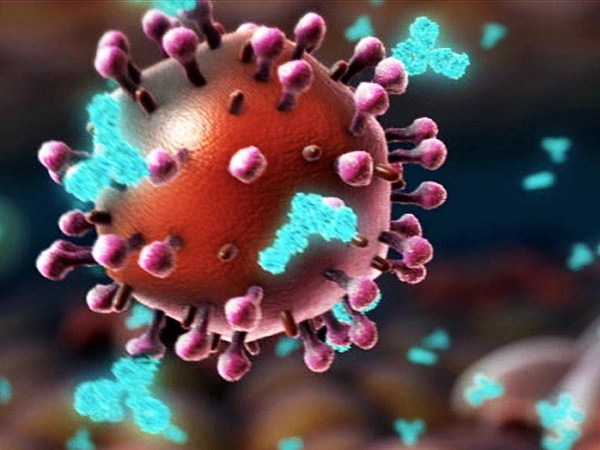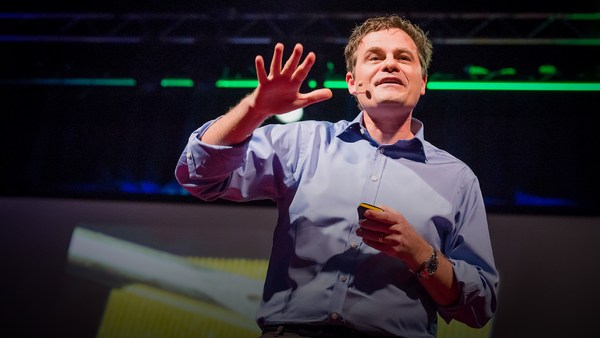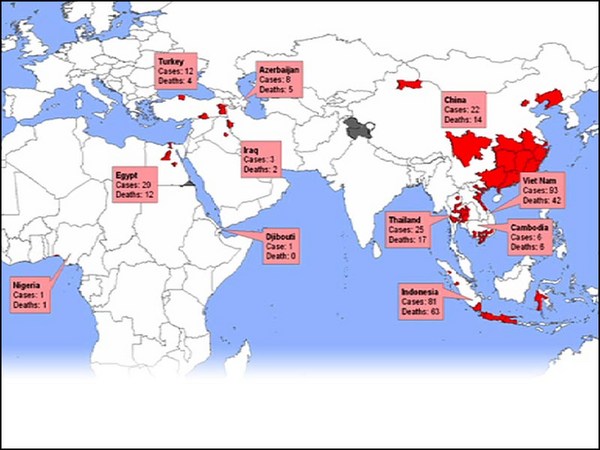In 1796, Dr. Edward Jenner created the first vaccine by inoculating a young boy with cowpox, a virus that's similar to smallpox. This inoculation caused the boy's immune system to make antibodies that would render the child resistant to smallpox, at a time that smallpox killed approximately 10% of the British population, including nearly half of all the infants infected by this virus. Jenner coined the term "vaccination" for this process, based on "vaccinia," the Latin term for cowpox. Other than clean drinking water, vaccination remains the most important public health intervention in human history. Jenner did get accolades for this important accomplishment during his lifetime, but there were also doubts, as illustrated in this etching that illustrates that some of the folks at the time were concerned that administering cowpox to people would make them grow horns. (Laughter) Fortunately, that was not the case. And with the help of this vaccine, smallpox was eradicated in 1980. It is hard to overstate the beneficial effects of immunization. This quote from Dr. Stanley Plotkin, who's been studying vaccines for over 60 years, hits the mark. According to the US Centers for Disease Control, US children born over the last 20 years - for those children, vaccines will prevent greater than 322 million illnesses, greater than 21 million hospitalizations and greater than 730,000 deaths, with the societal cost savings of nearly 1.4 trillion dollars. Those are big numbers, but let's zoom in and look at a particular example. Vaccines have nearly eliminated a bacterial infection called Haemophilus influenzae. This bacterium used to infect young infants, causing bloodstream infections, pneumonia, meningitis, death or permanent disability. As a young pediatrician, I saw a few cases. You folks probably have never heard of this disease because vaccines have been so effective. You could see in the graph on the right that since the introduction of vaccines, the incidence of Haemophilus bacterial infections has plummeted like a rock, and it's nearly vanished. This is just one example. I can give you many others. So vaccines are generally a success story, but we also face challenges. For one, for most vaccines, we need to give multiple doses to achieve or maintain protection. The scientific community is working on developing single-shot vaccines. Imagine being able to get only one influenza shot your whole life and not having to get a seasonal flu vaccine. For certain microbes, they're difficult to immunize against. A classic example is human immunodeficiency virus, or HIV. The need is urgent. Progress is being made. We're not there yet. Another critical element in vaccine research right now is optimizing vaccines for the most vulnerable among us: the very young and the elderly. And this is an active area of research. Finally, one of the biggest challenges we, unfortunately, face right now are anti-vax attitudes. In fact, it's alarming that over 100,000 infants and children in the United States have not received any vaccines, and that number is growing. In fact, the World Health Organization, or WHO, has declared anti-vax attitudes as one of the 10 most important threats to human health in the world today. This graphic illustrates the spread of anti-vax sentiment in the state of California from the year 2000 to 2013 by looking at the percentage of public kindergarten students who claim the personal exemption against immunization. Anti-vax sentiment is on the rise, and it has very real consequences. Many of you may be aware of the fact that we're seeing infections that we thought we conquered long ago coming back. Measles outbreaks have been reported in multiple US states, and many have forgotten, but measles is very infectious and dangerous. Just a few viral particles can infect an individual. And there have been even reports at sporting events, at an Olympic Stadium, where the virus, through the air, travels long distances and infects a vulnerable person in the crowd. In fact, if I had a measles cough right now, (Cough) somebody in the back of this auditorium could get infected. And this has had very real-world consequences. Just a few months ago, an airline stewardess contracted measles on a flight, the virus entered her brain and caused encephalitis, and she died. So people are now dying due to this anti-vax sentiment. I do want to take a few minutes to address those who don't believe in vaccines and who resist vaccines. As a pediatrician who receives my yearly flu vaccination, as a parent of three children who have been vaccinated according to the recommended schedule, and as a pediatric infectious disease consultant who's taken care of young children with meningitis that would have been preventable had their parents accepted immunization, this is a personal matter to me. Let's take a look at who is going to pay the price if we start dialing back the amount of vaccination in our society. This graph depicts on the Y-axis the number of individuals dying of infection in the world. And on the X-axis, the age of the individuals who are dying. And as you can see, it's very much a U-shaped distribution, and it's particularly stark in the very young ages. So vaccines shield the very young from infection. And if we want to talk, my friends, about what vaccines cause - because there's a lot of speculation, unfounded speculation, on the Internet of what vaccines cause - vaccines cause adults, OK? That's what they cause. And the other thing that they cause is for elderly individuals to live longer because they are shielded against influenza and other killers of the elderly. Now let's talk a little bit about how we can improve vaccines even further. We can create vaccines that can immunize the most vulnerable among us and perhaps even vaccines that protect with single shots. Let me go over a little bit of the immunology. In the top panel, what you see is a simple vaccine. All vaccines contain something called an antigen. The antigen is like a piece of a germ of a microbe that your body remembers. It forms antibodies, and those antibodies can protect you. Right? So those kind of vaccines can induce an immune response. But as you see here, that immune response tends to go up and back down, and you need to get another dose and another dose to maintain protection. What can we do? We and other scientists around the world are finding molecules that can boost a vaccine response. Those are called "adjuvants," from the Latin "adjuvare" - "to help or aid." Adjuvants are molecules we might add to a vaccine to get a stronger response. And in the presence of the adjuvant, depicted here in red, you have a much more profound activation of the white blood cells of your immune system and generate a much more profound immune response with much higher antibody levels more rapidly and that lasts a long time for durable immunity. Interestingly, these advjuents have different effects depending on the age or other demographic factors of the individual. Which brings me to the notion of precision vaccines. This is the idea that we will take precision medicine - you know what precision medicine is, right? That's the idea that populations may vary in their response to a particular medicine and apply that to vaccines. Right? And here in Boston Children's Hospital at the precision vaccines program I direct, we have five stepwise approaches we take to build precision vaccines that are tailored to vulnerable populations. Number one, we need to understand what the attitude of a given population is towards a vaccine. You could build the most sophisticated vaccine in the world, but if nobody wants to take it, you're going nowhere. Number two, we have to think of the route of immunization. Most vaccines are intramuscular, or IM, but there are others - intranasal, oral and others. Then, as I just described to you, vaccines have components. All vaccines have an antigen. That's the part of the microbe that your body remembers, that you might make antibodies or cell-mediated immunity against. And we might add an adjuvant, as we talked about, to boost an immune response. But guess what? There are many different antigens to choose from and many different adjuvants. How are we going to make that decision? And the menu of these keeps growing. So on our team, we've developed ways to test vaccines outside the body - in Latin, that's "in vitro" - in a tissue culture dish. So we use tissue engineering with blood cells to immunize outside the body and study the effect of the vaccine against, for example, infants or elderly individuals or others. And if you think about it, this is critical. Because if you look at all the infections we want to build vaccines against, like Zika virus and Ebola virus and HIV and others, all the candidate antigens, all the candidate adjuvants, all the different populations - it's going to be impossible to do large phase 3 clinical trials for every combination. This is where we think being able to test vaccines outside the body can make a big difference to accelerate vaccine development. And finally, this whole effort is to drive an immune response that will protect against that particular pathogen, of getting antibodies and other cells to defend the body. We are also using additional innovative approaches to bring the most cutting-edge science to vaccine development. We are taking a deeper dive as to how current vaccines protect. We've formed an international consortium to study how hepatitis B vaccine protects newborns from hepatitis B infection. And to do this, we've developed a technique called "small sample, big data." We can get a tiny little drop of baby blood before immunization and take a tiny little drop after immunization, and we can measure the inventory of all the cells and all the genes and all the molecules in that drop of blood, and we can compare after the vaccine to before the vaccine in that same baby and understand in a deep way exactly how that successful vaccine protects. And those lessons we can use to build the next vaccines in the future. So this diagram is really illustrating a tiny drop of blood yielding huge amounts of information, tens of thousands of analytes, and that hairball is meant to depict the gene pathways that are turned on and the molecular pathways that are turned on. So much more to come on that, and very exciting science. So we were partnering with scientists around the world to bring all these new technologies to invigorate vaccine development in a precision vaccines network. We are going to advance personalized vaccines for vulnerable populations around the world. And our team includes scientists, technical experts and physicians. And we're developing vaccines against infectious diseases like pertussis, which is whooping cough. We have a whooping cough vaccine, but it requires multiple doses and the immunity keeps dropping. We want to develop a single-shot pertussis vaccine. We're working on a vaccine for respiratory syncytial virus, the number one cause of infant hospitalization in the US, a better vaccine against influenza, and, of course, HIV. We're also looking at vaccines against cancer, allergy and, interestingly, opioid overdose. So this is my final message to you. Vaccines protect you and your loved ones and the people around you. Not only do they protect you against infection, they prevent you from spreading it to others. Get immunized. The scientific progress is fragile and can be lost. We must foster accurate and respectful public dialogue. And finally, we're on the verge of great things, a new era of vaccination. We've just scratched the surface of what can be accomplished. Please advocate for this research. Thank you. (Applause)
Related talks

Seth Berkley: HIV and flu -- the vaccine strategy

Mark Kendall: Demo: A needle-free vaccine patch that's safer and way cheaper

Bruce Aylward: How we'll stop polio for good

Romina Libster: The power of herd immunity

Seth Berkley: The troubling reason why vaccines are made too late ... if they're made at all
